Ihram
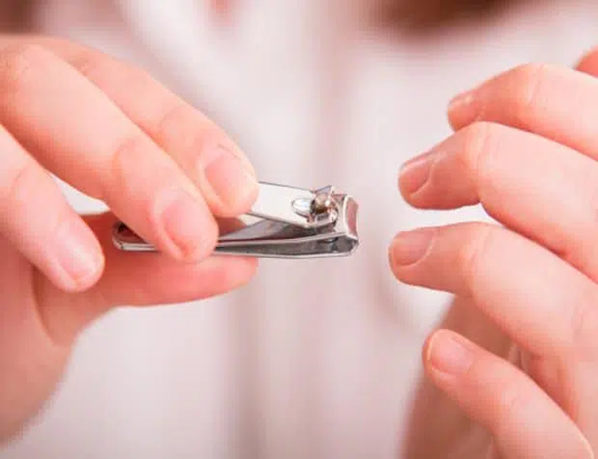
Preparation Prior to wearing the Ihram attire, you should be in a state of physical purity and take care of your personal hygiene at home If you haven’t done so already, you should ensure you: Clip your finger and toenails.
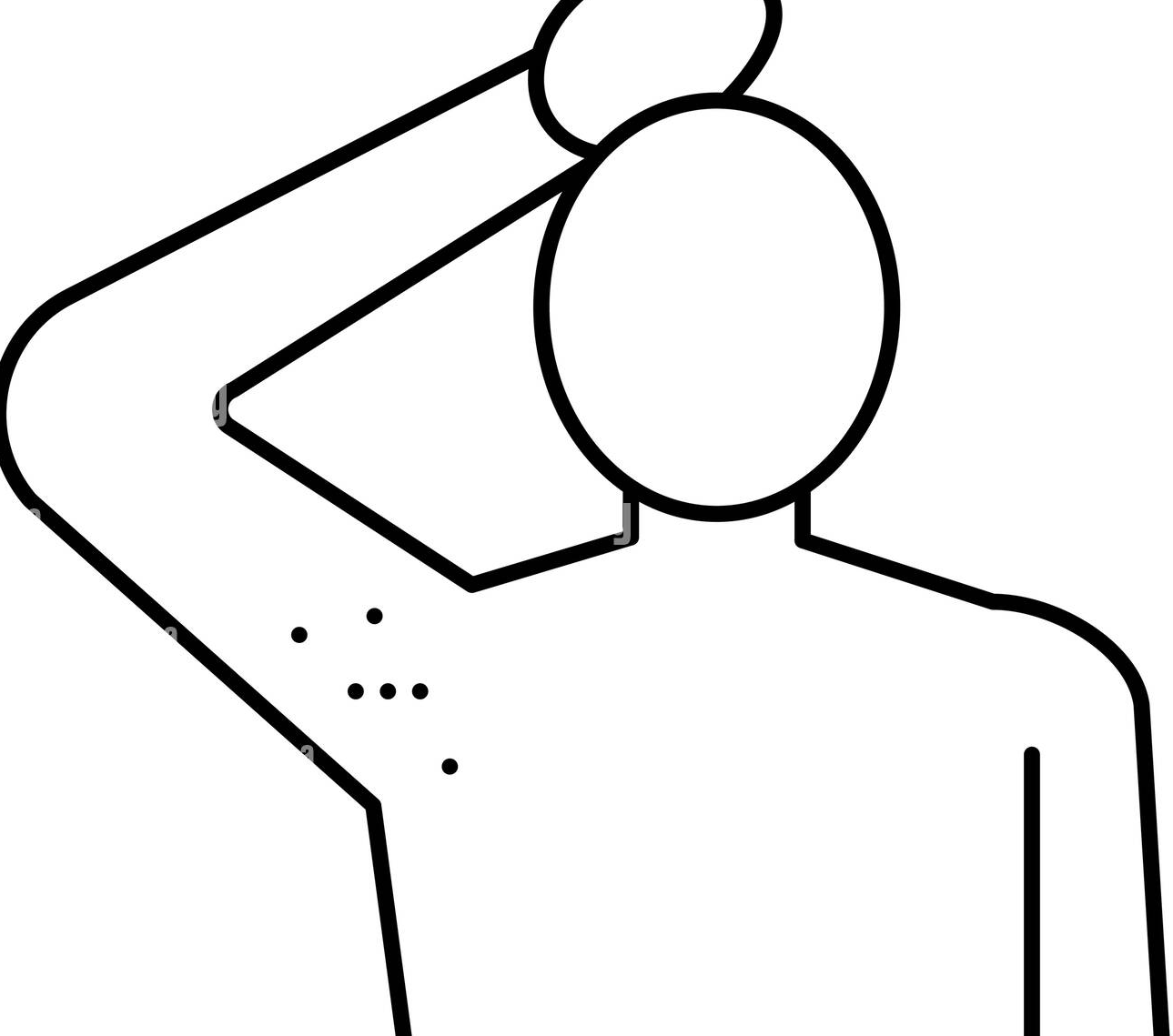
Remove the hair under the armpits.
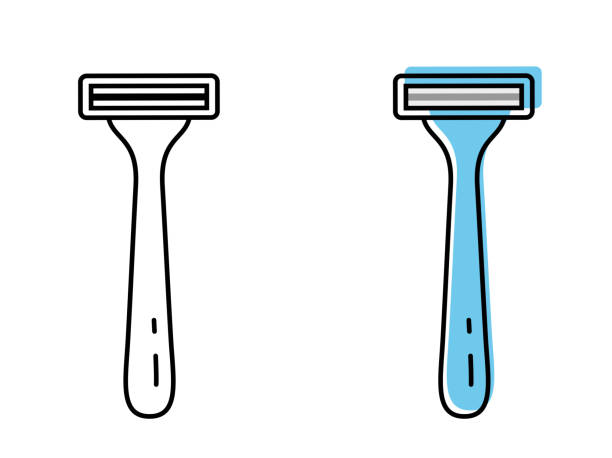
Remove the hair under the navel.
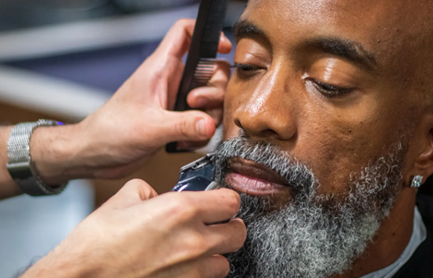
Trim the moustache.
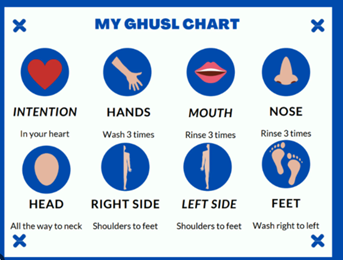
You should then perform Ghusl. One should perform Ghusl in a private place without facing towards the Qibla (the direction of Kaaba) and in a sitting or standing position. It is also said that one should use sufficient water and refrain from speaking whilst performing a ritual bath. He/she should wash both his/her hands and private parts thoroughly. When you are through with the bath, if there is a certain portion on the body left dry, then you don’t necessarily have to perform Ghusl again but just wash the portion accordingly. And, if you forget to wash your nostrils, mouth, ears and navel, then wash them as well.
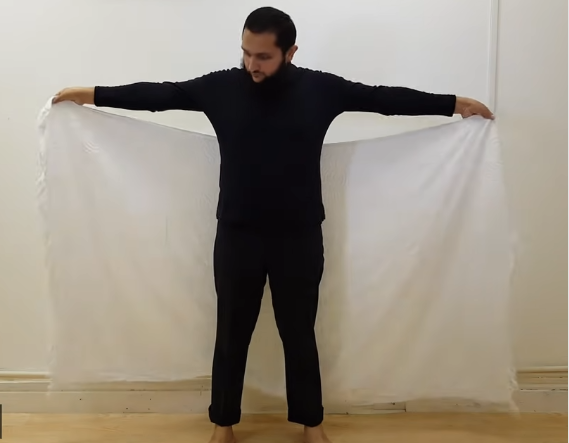
Ihram for men Men should remove any clothing that is stitched or tailored to fit the shape of the body such as shirts, trousers, vests and underwear before entering the state of Ihram. You may delay removing any clothing that violates the conditions of Ihram such as underwear until the point of Miqat, at which stage the intention for Ihram should be made. Put on the Izar as follows: 1、Stand with your legs shoulder-width apart ensuring you have enough room to walk freely once it’s tied. Maintain this position until the bottom part of the Ihram is secure. 2、Proceed to wrap the top part around the waist. Depending on the length of the garment, you will be able to wrap the garment around your waist more than once. 3、Once the Ihram is wrapped around your waist, begin to fold and tuck in from the top of the Ihram in increments of about 10 cm. This should ensure the Ihram is held securely. 4、The Izar should cover your entire Awrah. Any portion of your body from your navel to your knees should not be visible.
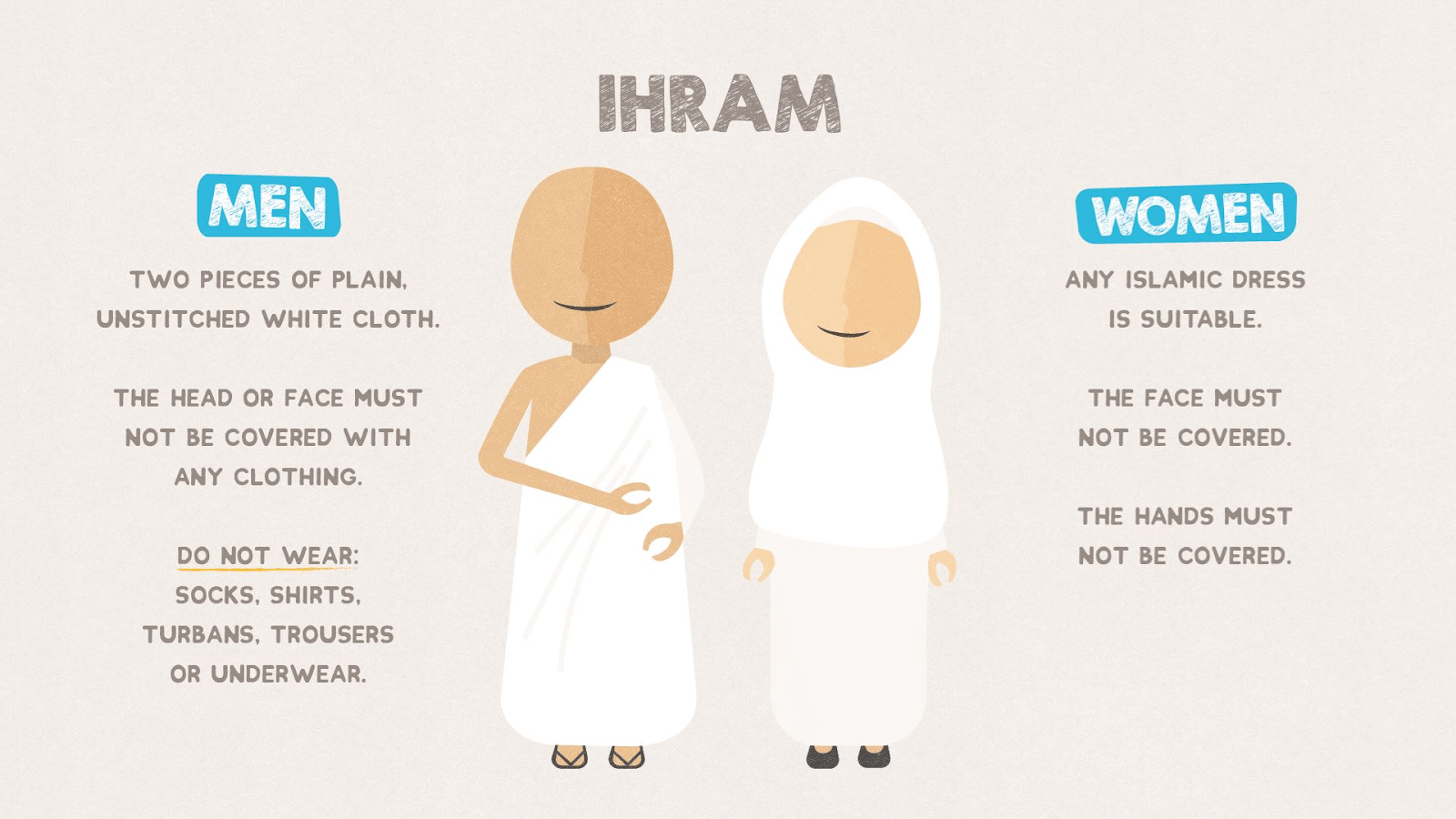
Ihram for Women Women are not required to conform to a specific dress code and are free to wear what they please. Needless to say, clothing should be normal, modest Islamic dress with a head covering of any colour. Socks may be worn but the hands and faces must be uncovered. Although covering the face is prohibited, using a cloth that hangs over the face without touching it is permissible.
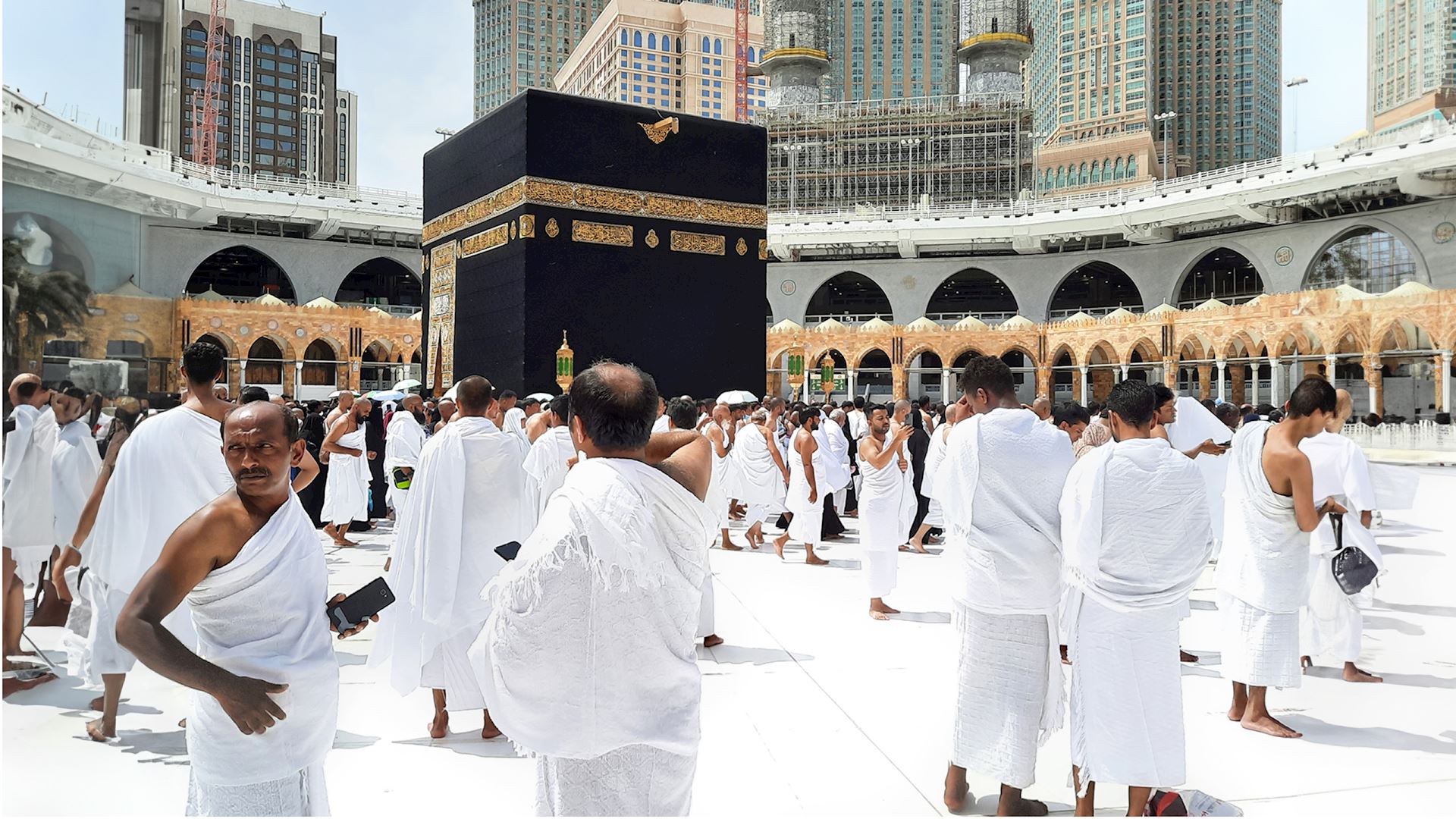
When to Enter into Ihram Ihram must be assumed before crossing the Miqat boundary. If the Miqat is crossed without having entered into the state of Ihram, a penalty will be due in atonement, although the Hajj or Umrah will remain valid. According to the Hanafi school of thought, it is more meritorious to enter into Ihram while starting the Hajj journey from one’s hometown, while the Maliki and Hanbali schools affirm that assuming Ihram before the point of Miqat is more virtuous. Assuming you choose to enter into Ihram before the point of Miqat and you’re travelling by air, you will have different options on where you can change into your Ihram attire, depending on the airline you’re flying with.
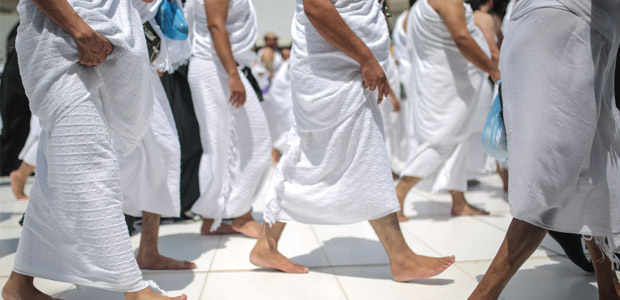
Salah al-Ihram
After changing into your Ihram, it is Sunnah to perform two Rakahs of Salah al-Ihram before making the intention to enter into the state of Ihram, by consensus of all four schools of law. This should be performed before the Miqat has been crossed. Provided it isn’t one of the prohibited times for prayer, observe the Salah with the intention of performing two Rakahs Nafl for Ihram.
If any other prayer is performed after changing into the Ihram attire and before pronouncing the intention, whether it is obligatory or Sunnah (such as the two Rakahs Salah for the greeting of the mosque), it will account for this prayer, even if there is no intention to do so.
Since you’re not in the spiritual state of Ihram yet, you may perform the Salah with your head covered. It is a Sunnah to recite Surah al-Kafirun (Qul Yā Ayyuha-l-Kāfirūn – Surah 109) in the first Rakah and Surah al-Ikhlas (Qul Huwa-llāhu Ahad – Surah 112) in the second Rakah after Surah al-Fatiha, although any other Surah may be recited. Once you’ve finished, remove any headwear or anything else that may violate the rules of Ihram and get ready to make your intention.
Women in a state of menstruation should not perform the Salah, rather they should make their intention for Hajj or Umrah and recite the Talbiyah.
If you’re flying to Jeddah, either directly or via a connecting flight, it is a good idea to perform Salah al-Ihram at the airport before boarding the plane and then making your Niyyah on board before crossing the Miqat (about an hour before arriving at Jeddah airport). Delaying the Niyyah until the last moment is a good way of ensuring the restrictions of Ihram aren’t needlessly violated during or before the flight, particularly if flights are delayed or cancelled.
If you’re flying with an Islamic airline and choose to perform Salah al-Ihram on the plane, you may find that there is a rush of people intending to perform the Salah making it difficult and uncomfortable to observe the prayer.

Ihram on the plane Ensure you put on your Ihram attire before crossing the designated Miqat. You will likely be travelling to Saudi Arabia via plane, so it is advisable to get changed into your Ihram at the airport prior to departure or during a stopover if you have one. Check in first and get changed in the prayer room or bathroom. Alternatively, you can put on your Ihram in-flight although bear in mind that aeroplane bathrooms are usually very limited in space and there may well be a rush of people intending to do the same thing as the Miqat approaches. If you decide to change into your Ihram attire on the plane, do so at least an hour before the Miqat is crossed.
If you’re flying with an airline such as Saudia, you will have access to a prayer area during the course of the flight. About 20 or 30 minutes away from the Miqat, you will be informed by the captain or a message will appear on the screen informing you that the Miqat is approaching. At this point, you should change into your Ihram if you haven’t done so already. It is advisable to get changed about an hour before the point of Miqat if you want to avoid the rush of people intending to get changed as the Miqat approaches. You may then pronounce your intention and recite Talbiyah at the point of Miqat. If you feel uncomfortable getting changed on board or you think you may have difficulties in doing so, follow the approach above and put on the Ihram at the airport before departure.

Niyyah The Niyyah for Umrah should be made at the Miqat or close to it as you move in its direction. Ideally, you should delay making the intention until the last moment so you aren’t restricted by its prohibitions for longer than need be. It is recommended (Mustahabb) that you make the intention verbally, as well as reiterating it internally. Following are three examples of intentions that may be uttered in Arabic: لَبَّيْكَ اللَّهُمَّ عُمْرَةً Labbayka llāhumma ‘umratan. O Allah, here I am to perform Umrah. اللَّهُمَّ إِنِّيْ أُرِيْدُ الْعُمْرَةَ Allāhumma innī urīdu l-‘umrata. O Allah, I intend to perform Umrah. اللَّهُمَّ إِنِّيْ أُرِيْدُ الْعُمْرَةَ فَيَسِّرْهَا لِيْ وَتَقَبَّلْهَا مِنِّيْ Allāhumma innī urīdu l-‘umrata fa yassirhā lī wa taqabbalhā minnī.

“Talbiyah
After making your Niyyah, you must recite the Talbiyah to validate your intention and enter into the state of Ihram. The utterance of the Talbiyah is Wajib according to the Hanafi and Maliki schools of thought. The Shafi’i and Hanbali schools consider it a Sunnah.
You must recite the Talbiyah at least once after making your intention for Umrah. Failure to do so will result in an invalid Umrah!
The Sunnah method of reciting the Talbiyah is to briefly pause at four places, indicated by the dashes. The prayer is as follows:
لَبَّيْكَ اللهُمَّ لَبَّيْكَ – لَبَّيْكَ لَا شَرِيْكَ لَكَ لَبَّيْكَ – إِنَّ الْحَمْدَ وَالنِّعْمَةَ لَكَ وَالْمُلْكَ – لَا شَرِيْكَ لَكَ –
Labbayka llāhumma labbayk(a), labbayka lā sharīka laka labbayk(a), inna l-ḥamda wa n-ni’mata, laka wa l-mulk(a), lā sharīka lak.
At Your service, Allah, at Your service. At Your service, You have no partner, at Your service. Truly all praise, favour and sovereignty are Yours. You have no partner
Once the intention has been made and the Talbiyah has been uttered, you will have entered the sacred state of Ihram. A pilgrim in the state of Ihram is known as a Muhrim. As a Muhrim, you must be aware of the prohibitions of Ihram. You must also be conscious and mindful of God on all occasions, exercise patience and exhibit good character.
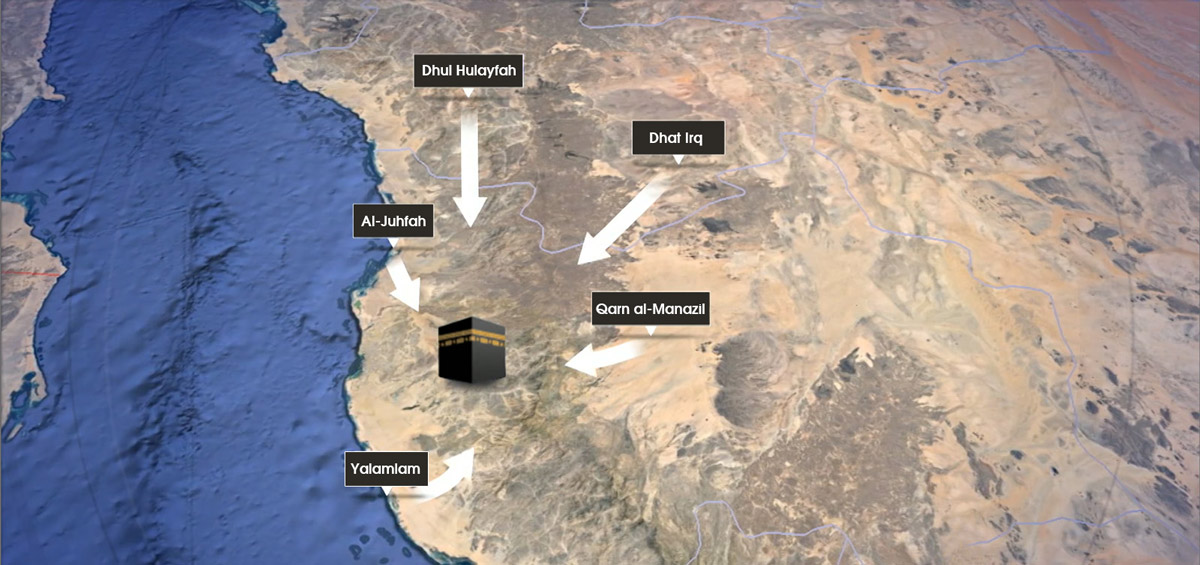
Ihram at Miqats
If you are travelling to Saudi Arabia by train or bus, you will have to travel to Miqat for Ihram.
Firstly, you get changed into the Ihram garments before the Miqat, perform two Rakahs of Salah and make your Niyyah as the Miqat approaches, thereafter reciting the Talbiyah frequently.
Ihram is obligatory beyond a certain (geographical) boundary called Miqat. Pilgrims should wear Ihram before or at the time of entering the miqat. Once a person enters a miqat, he/she cannot remove the Ihram clothing until the pilgrimage is completed. There is 5 Miqtas.
1、Dhul Hulayfah (also known as Abyar Ali)
Dhul Hulayfah is located 18 kilometres southwest of Masjid al-Nabawi in Madinah and is 410 kilometres (255 miles) north of Makkah. This is the Miqat for the people of Madinah and the people (outside of Madinah) intending to perform Hajj by passing beyond this point coming from the North.
2、Al-Juhfah (also known as Rabigh)
Al-Juhfah is located 182 kilometres (113 miles) northwest of Makkah. This is the Miqat for people intending to perform Hajj travelling from North America, Europe, Turkey, Syria, Egypt, Algeria, Sudan and several other African countries. Pilgrims may also enter into Ihram at Rabigh, a town just to the north of al-Juhfah
3、Qarn al-Manazil (also known as al-Sayl)
Qarn al-Manazil is located 80 kilometres (50 miles) east of Makkah. This is the Miqat for the people of Najd and for those travelling from countries such as the U.A.E, Oman, Pakistan, Australia, Malaysia, Singapore etc. It is situated near the city of Ta’if.
4、Dhat Irq
Dhat Irq is located 90 kilometres (56 miles) northeast of Makkah. This is the Miqat for people intending to perform Hajj travelling from Iraq, Iran, China, Russia etc.
5、Yalamlam (also known as al-Sadiah)
Yalamlam is located 100 kilometres (62 miles) south of Makkah. This is the Miqat for the people of Yemen and those coming from the south. Pilgrims travelling from countries such as South Africa, Nigeria etc. will cross this Miqat.
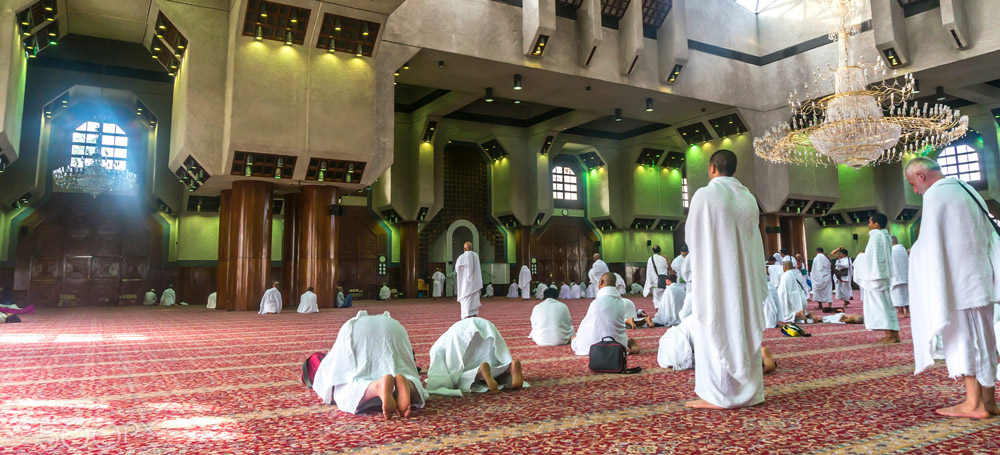
Miqat
You may delay making your intention until the Miqat approaches. Just before crossing, remove any articles of clothing that you may still be wearing that violate the conditions of Ihram such as socks, headwear and underwear.
Women aren’t required to conform to a specific dress code. Clothing should be normal modest Islamic dress with a head covering of any colour. Hands and faces must remain exposed although socks may be worn.
Completion of Salah al-Ihram and Niyyah, Talbiyah as per previous steps

Once ihram is worn twenty five matters become forbidden:
1. Hunting.
2. Sexual intercourse.
3. Kissing a woman.
4. Touching a woman.
5. Looking at a woman and flirting with her.
6. Masturbating
7. Reciting nikah.
8. Use of scent or perfume.
9. Wearing sewn clothes by men.
10. Applying collyrium (surma).
11. Looking in a mirror.
12. Wearing shoes, slippers or socks.
13. Lying.
14. Quarrelling.
15. Killing lice or other like insects found on humans.
16. Beautifying oneself.
17. Applying oil.
18. Removing hair from the body.
19. Covering the head by males or diving in water even by females.
20. Covering of the face by females.
2l . Being under shade by males.
22. Taking out blood from the body.
23. Cutting nails.
24. Extracting tooth, as stated by some scholars.
25. Carrying arms.

What is permissible during Ihram:
1. Wear a wristwatch, ring,eyeglasses,earphones.belt and sandals below the ankies.
2. Shade oneself under an umbrella orceiling,including that of a car or bus.
3. Carry baggage, matresses, etc.,onhis head.
4. Bandage a wound
5. Change one’s garments, as well ascleaning or washing them.
6. Wash his/her head and body. lf anyhair should come out unintentionally itis excused.
Additionally, if a man covers his headwith a cap or cloth out of forgetfulnessor ignorance he must remove it assoon as he remembers or knows, andthere will be no ransom due from him.